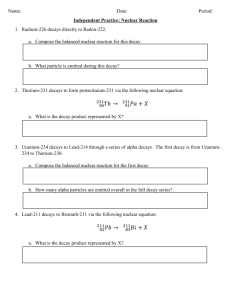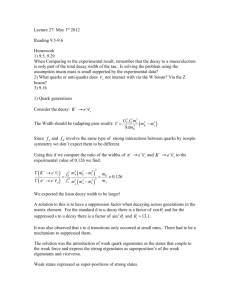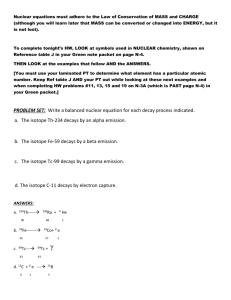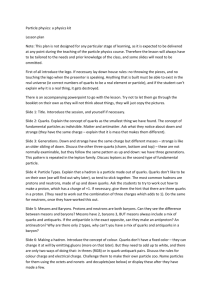Dr Victoria Martin, Prof Steve Playfer Spring Semester 2013 Lecture
advertisement
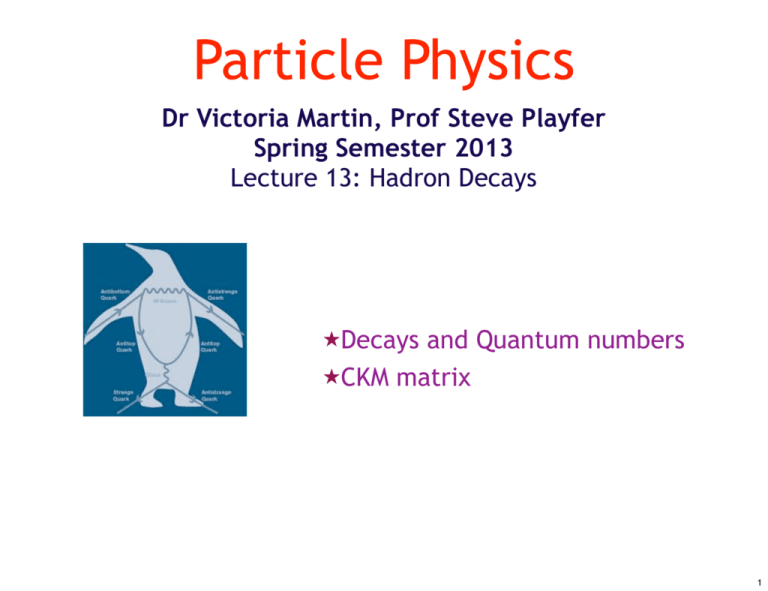
Particle Physics Dr Victoria Martin, Prof Steve Playfer Spring Semester 2013 Lecture 13: Hadron Decays ★Decays and Quantum numbers ★CKM matrix 1 Decays of Hadrons Force Typical τ (s) QCD 10−20 - 10−23 QED 10−20 - 10−16 • The proton is the only completely stable hadron • The free neutron has a weak decay (~15 mins) Weak 10−13 - 103 • Decay length of a particle is distance it travels before decaying L=βγcτ • π±, K±, KL0 mesons are long-lived (~10 ns) and have weak decays ➡ These particles live long enough to travel outside radii of collider detectors (~10 m) • KS0 mesons and Λ0 hyperons are long-lived (~100 ps) and have weak decays with decay lengths of ~ cm. • π0→γγ, η→γγ are electromagnetic decays, reconstructed from pairs of photons. m2π = (p(γ1 ) + p(γ2 ))2 • ρ, ω, φ, Κ∗, Δ, Σ∗, Ξ∗ are resonances with strong decays. ➡ Reconstructed as broad structures with widths ~100 MeV. 2 Decay Conservation Laws • Relevant quantum numbers are: • strong isospin (I, I3) • parity (P) • quark flavour: described using strangeness (S=N(s)−N(s̅)), charm (C=N(c)−N(c̅)), bottomness (B=N(b)−N(b̅)) • Baryon number and lepton numbers are always conserved! Strong Strong baryon Flavour, Parity, P Isospin, Isospin, number S, C, B I I3 Strong Y Y Y Y Y EM Y N Y Y Y Weak Y N N N N 3 Decays of Charmonium • The J/ψ meson is a c c̅ state. 4 It must decay to particles without charm quarks as 2007/08 — Physics 3: Particle Physics M(J/ψ) < 2 M(D). The down and anti-down quarks annihilate by producing a gluon. The gluon can be absorbed by any of the quarks. Remember as long as the flavour of the quark doesn’t change, a gluon Physics can be emitted or absorbed by any quark. After about Physics 3: Particle 10−24 s (any) one of the quarks emits a gluon which turns into a dd̄ pair. It decays so quickly as the strong coupling constant is large, so the quarks are very likely to emit an energetic enough gluon to make a dd̄, and because the minimum energy state is favoured. The mass of the pion and the proton is smaller than the mass of the ∆++ . — 5 decay via three gluons (to conserve colour and parity) or one • Two options: 2007/08 photon. This looks like a pretty silly Feynman diagram, but the uuu state actually lives for slightly longer than just three quarks would if they didn’t form a bound state. 6. The J/ψ meson was discovered through its electromagnetic decays into e+ e− and µ+ µ−. However, the J/ψ decays mainly through strong interactions such as: J/ψ → π + π −π 0 . Draw the Feynman diagram for these decays, and hence explain why, although most of the decays of J/ψ are due to the strong force, it has a relatively long lifetime. Hint: You have to consider both colour charge and parity. The J/ψ meson, has parity π = −1, gluons have parity π = −1. For the J/ψ → π π π , 6 three gluons are required to conserve colour and parity. by α (qgluon). This is comparable to the rate for S • Decay rate is suppressed To see this you have to consider the colour charge, as shown in the Feynman diagram crossbelow. section therefore proportional to α instead . Thisof give longer lifetime than if (I know they are labelled as strange quarks, charmaquarks, 2 is that electromagneticThe decay α the argument is the same.) The J/ψ meson has no net colour charge, let’s only onebut gluon was exchanged. + − 0 6 S say that the quark has red colour charge and the anti-quark has anti-red colour − 0 more than one quark charge. Therefore theelement red s quark M(J/ψ and anti red→ s̄ quark require This makes the matrix π+π π ) small compared to most strong to annihilate. Just one gluon would have red-anti-red colour charge, which isn’t a decays. Therefore there is colour relatively gluon; as all gluons carry charge. small probability per unit time that this decay Both strong and electromagnetic final states have large branching ratios. happens,Two giving longbut lifetime. gluons the wouldJ/ψ allow ausrelatively to conserve colour, two gluons have a total parity The J/ψ meson lives for a relatively long time, giving rise to narrow resonance in • of π(gluon) × π(gluon) = −1 × −1 = +1, and we need π = −1. In fact it’s a long enough lifetime to give the J/ψ → µ µ decay a chance to + − e.g. e e → hadrons. contribute as well. ➡ + − 7. What is meant by colour confinement? Colour confinement describes the phenomena where quarks are only found in hadrons. The gluons exchanged between the quarks self interact. The potential between two quarks, due to the gluon interactions is V (r) = kr. The energy stored between the quarks increases as they are pulled apart! • Similar phenomena occurs in decays of s s̅ and bb̅ mesons. 4 Charged Pion Decay • See problem sheet 1 • π+ consists of ud̅, lightest charged meson • τ(π+) = 26 ns • must decay via weak force, weak is the only force Vud that can violate quark flavour ➡ CKM matrix element factor Vud. ➡ hadronic form factor fπ ~ mπ to account for finite size of pion � � 1 µ 5 + ū(νµ )gW γ (1 − γ )v(µ ) 2 2 q − mW � �� � µ 5 µ 5 + v̄(d̄)γ (1 − γ )u(u) ū(νµ )γ (1 − γ )v(µ ) � � µ 5 M = v̄(d̄)gW Vud fπ γ (1 − γ )u(u) 2 gW ≈ Vud fπ 2 mW |M|2 = 4 G2F |Vud |2 fπ2 m2µ [pµ · pν ] 2 |� p ∗| G 2 2 2 2 2 2 F Γ= |M| = |Vud | fπ mµ (mπ − mµ ) 2 8πm1 8π 5 Charged Kaon Decays • Charged kaon is s̅ u with mK = 498 MeV • lightest mesons containing strange quarks decay by weak force • τ(K±) = 12 ns • Leptonic decays • BR(K+→µ+νµ) = 63% • Kaon decay constant, fK=160 MeV • Vus = 0.22 must u νµ Vus fK µ+ s̅ μ+ W+ • Semileptonic decays • BR(K+→π0µ+νµ) = 3.8% • BR(K+→π0e+νe) = 5.1% s̅ u νμ d̅ u • Hadronic Decays • BR(K+→π0π+) = 21 % • BR(K+→π+π+π−) = 5.6% 6 Cabibbo-Kobayashi-Maskawa Matrix • Mass eigenstates and weak eigenstates of quarks are not identical. ➡ Decay properties measure mass eigenstates with a definite lifetime and decay width ➡ The weak force acts on the weak eigenstates. • Weak eigenstates are admixture of mass eigenstates, conventionally described using CKM matrix a mixture of the down-type quarks: weak eigenstates d� Vud s� = Vcd b� Vtd Vus Vcs Vts Vub d mass Vcb s eigenstates Vtb b • e.g. weak eigenstate of the strange quark is a mixture between down, strange and bottom mass eigenstates s� = Vcd d + Vcs s + Vcb b • The CKM matrix is unitary, VCKM†VCKM = 1; standard parameterisation in terms of three mixing angles (θ1, θ2, θ3) and one phase (δ) is: cos θ1 − sin θ1 cos θ3 sin θ1 sin θ2 sin θ1 cos θ3 cos θ1 cos θ2 cos θ3 − sin θ2 sin θ3 eiδ − cos θ1 sin θ2 cos θ3 − cos θ2 sin θ3 eiδ sin θ1 sin θ3 cos θ1 cos θ2 sin θ3 + sin θ2 cos θ3 eiδ − cos θ1 sin θ2 sin θ3 + cos θ2 cos θ3 eiδ 7 Nobel Prize in Physics 2008 Awarded to Makoto Kobayashi, High Energy Accelerator Research Organization (KEK), Tsukuba, Japan and Toshihide Maskawa, Yukawa Institute for Theoretical Physics (YITP), Kyoto University, and Kyoto Sangyo University, Japan "for the discovery of the origin of the broken symmetry which predicts the existence of at least three families of quarks in nature" 8 Experimental Measurements of CKM Matrix • Many measurements made by the BaBar and Belle experiments. • Both study e+e−→ Υ(4s) → B0 B̅0 to measure the decays of b and c quarks, e.g. Vcb and Vub BaBar at SLAC California, 1999 - 2008 Belle at KEK, Japan 1999-2010 BaBar 2007 B → D* ℓ ν decays (as function of D* recoil) measures |Vcb| = 0.0374 ± 0.0017 Exclusive B → π ℓ ν (as a function of q2) |Vub| = 0.0034(5) 9 The Wolfenstein Parameterisation • An expansion of the CKM matrix in powers of λ = Vus = 0.22 VCKM 1 − λ /2 −λ = Aλ3 (1 − ρ − iη) 2 λ 1 − λ2 /2 −Aλ2 Aλ (ρ − iη) + O(λ4 ) Aλ2 1 3 • Parameterisation reflects almost diagonal nature of CKM matrix: ➡ The diagonal elements Vud, Vcs, Vtb are close to 1 ➡ Elements Vus, Vcd ~ λ are equal ➡ Elements Vcb, Vts ~ λ2 are equal ➡ Elements Vub, Vtd ~ λ3 are very small • Diagonal structure means quark mass eigenstate is almost equal to down quark weak eigenstate • similarly for strange and bottom mass eigenstates • Note that the complex phase η only appears in the very small elements, and is thus hard to measure. 10 Flavour Changing Neutral Currents • At 1st order, there are no allowed transitions between quarks of the same charge, e.g. s↔d, c↔u, b↔s, b↔d • Neutral current (the Z boson) does not change the flavour of the fermion. • At 2nd order so-called “Penguin Diagrams” can cause transitions such as b↔s • e.g. b → s s s̅, B0→J/ψ K0 J/ψ B0 K0 B0→J/ψ K0 11 Neutral Meson Mixing • Second order weak interactions mix long-lived mesons with their antiparticles: K0 ( s̅ d ) , D0 ( c̅ u ), B0 (b̅ d), Bs (b̅ s) ➡ K0 ↔ K̅0 D0 ↔ D̅0 B0 ↔ B̅0 Bs ↔ B̅s Observed particles (weak decay eigenstates) are mixtures of flavour eigenstates. e.g. • KS = 1/√2 (K0 + K̅0 ) with τS = 0.09 ns • KS = 1/√2 (K0 − K̅0 ) with τL = 51 ns −12 MeV = 0.53 x 10−10 s−1 Mass difference Δm = m – m = 3.52(1) x10 K L S • is oscillation frequency More about this next week, when we talk about CP violation 12 CKM Fit • All measurements, including results from BaBar, Belle and LHCb experiments, penguin diagrams, neutral kaon mixing used to find best values for η and ρ parameters in Wolfenstein parameterisation. 13 Summary: Decays of Hadrons • Hadron decays give us insight into forces in particle physics. • Strong decays are characterised by very short lifetimes, τ ~ 10−20 - 10−23 s appearing as resonances with a large width Γ ~ MeV. ➡ Final states are all hadronic. All quantum numbers are conserved. • Electromagnetic decays are characterised by τ ~ 10−20 - 10−16 s. ➡ Decays containing photons are electromagnetic. ➡ All quantum numbers conserved except total isospin, I. • Weak decays characterised by long lifetimes, τ ~ 10−13 - 103 s. ➡ Responsible for decay of lightest baryons with a strange, charm or bottom quark. ➡ Particles can live long enough to reach the detector. ➡ Final states may be leptonic, semi-leptonic or hadronic. ➡ Allows access to the elements of the CKM matrix. ➡ Strong Isospin, I, I3, Parity, P, Flavour quantum numbers not conserved. • CKM matrix relates the mass eigenstates to the weak eigenstates. Contains a complex phase. 14



